The recent discovery that certain mouse species engage in behavior reminiscent of human first aid techniques sheds light on the innate altruism present within the mammalian kingdom. The findings of this study, conducted by researchers at the University of Southern California (USC), indicate that mice not only recognize when a companion is in distress but also attempt to revive them. This behavior underscores the notion that caring for others may be deeply rooted in evolutionary survival strategies and could be more widespread among mammals than previously acknowledged.
The intriguing aspect of the study is the involvement of specific brain regions and hormonal signals in the aid behavior of these mice. The researchers noted that the activation of areas of the brain responsible for involuntary functions coincided with these altruistic attempts. Specifically, when a conscious mouse encounters an unresponsive companion, it engages in what can only be described as a form of paramedic behavior. This involves not only physical actions such as pulling the tongue of the unconscious peer, which helps clear the airway, but also heightened neural activity that suggests a well-coordinated rescue effort.
Further analysis revealed the presence of oxytocin—a hormone known for its role in social bonding—triggered in the brain during these rescue attempts. This suggests that the behavioral response is not purely reflexive; rather, it signals a more complex interaction where mice can recognize their companions and act accordingly.
Interestingly, the study also indicates a behavioral bias that favors attempts to resuscitate familiar companions over strangers. This points to a level of social cognition that suggests the mice are actively assessing the situation instead of simply reacting out of instinct. University of Toledo neuroscientist James Burkett describes this sophisticated level of interaction as indicative of thoughtful behavioral mechanisms rather than mere instinctive behavior. Essentially, the conscious mouse seems to evaluate the identity of the distressed peer before deciding on a course of action.
This familiarity bias presents a compelling argument that the motivations behind these rescue attempts may include an emotional component, rather than a purely survival-driven response. The study’s implication is that linking social bonds to caregiving could have significant implications for understanding the evolution of altruistic behavior across species.
In conducting their experiments, Sun and his team presented the mice with various scenarios involving unconscious or immobile companions. They carefully evaluated the responses of the conscious mice to both familiar and unfamiliar subjects. It was fascinating to note that such a high percentage—50%—of conscious mice engaged in tongue-pulling actions, which effectively restored mobility to their partners. Beyond that, 80% of rescuer mice tended to remove obstructions placed within the mouth of their peers, showcasing an impressive ability to discern the needs of their companions.
The control experiments also included cases where rescue attempts were made on inanimate mice (those previously deceased), yet the conscious rodents displayed different behavior toward sleeping counterparts, highlighting their discernment capacities.
These findings are not merely a footnote in understanding mouse behavior but contribute to broader discussions about empathy and compassion within the animal kingdom. Similar altruistic behaviors have been documented in larger-brained mammals such as elephants and dolphins, which raises fascinating questions about the evolutionary pathways that led to such complex social interactions.
Equally, the neurological insights from this study could prompt further inquiries into the ways different species establish social bonds and determine their social hierarchies. The exploration of empathy among smaller mammals opens new avenues for research in both animal behavior and neuroscience, potentially informing conservation efforts and fostering better human-animal interactions.
The empathetic behavior observed in mice points to a significant evolutionary principle among mammals: that caring for others plays a vital role in survival strategies. As we delve deeper into understanding the complexities of these interactions, we must recognize that expressions of altruism, irrespective of species, may be more integral to our survival as a community than once believed. This research lays the groundwork for future studies and encourages a reassessment of how we view animal intelligence and empathy—including in species previously thought too simplistic to display such nuanced behaviors.


Leave a Reply